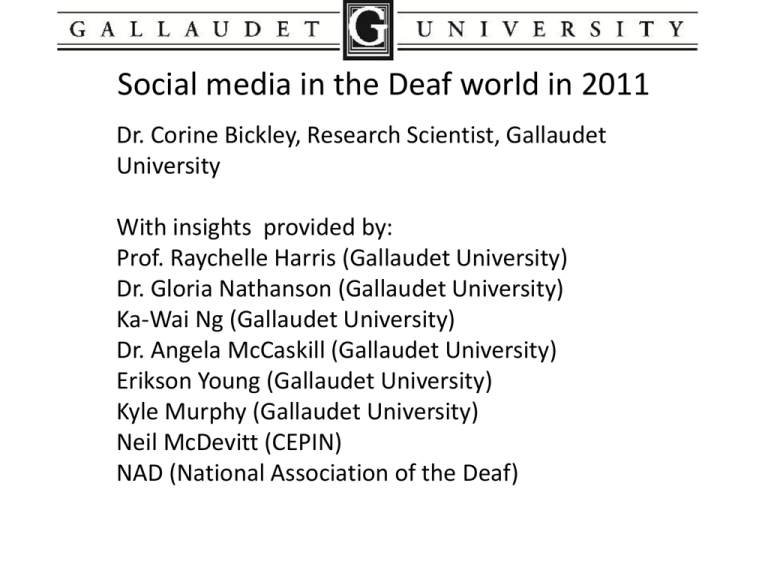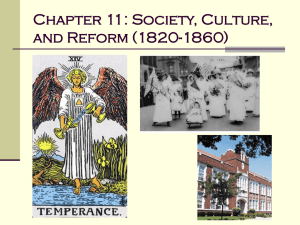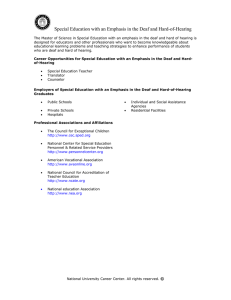Social media in the Deaf world in 2011
advertisement

Social media in the Deaf world in 2011 Dr. Corine Bickley, Research Scientist, Gallaudet University With insights provided by: Prof. Raychelle Harris (Gallaudet University) Dr. Gloria Nathanson (Gallaudet University) Ka-Wai Ng (Gallaudet University) Dr. Angela McCaskill (Gallaudet University) Erikson Young (Gallaudet University) Kyle Murphy (Gallaudet University) Neil McDevitt (CEPIN) NAD (National Association of the Deaf) Social media in the Deaf world in 2011 What’s wrong with this picture? Bismarck, ND, July 27, 2011 -- A billboard advertising FEMA's disaster website encourages residents affected by recent flooding apply for assistance. Photo by Patsy Lynch/FEMA TTY is OLD technology Social media in the Deaf world in 2011 How is social media used in the Deaf community NOW? • Information in video (ASL) • Announcements on Twitter • Comments on Twitter Social media in the Deaf world in 2011 Why is video important in social media for the Deaf? From Prof. Raychelle Harris (July, 2011): I suspect Facebook is more userfriendly, and allows for video/photosmore visual and more opportunities to use ASL. Twitter requires 140 characters or less, and primarily depends on English.... facebook is heavily used by deaf people who never went to college, and twitter is mostly used by deaf college graduates. For older deaf people, they're still using @aol.com or primarily depend on videophones (Sorenson)-- I know that because that describes my father (who is inept with social media, but hooked on his new iPad 2 and FaceTime now). Social media in the Deaf world in 2011 What form of social media is used in the Deaf community? Ka-Wai Ng comments: Deaf have the smartphone to type text messages (SMS) to others. Some deaf have the video camera feature on smartphone to call with their sign language (its feature looks like Video-phone). You can look at the example: http://www.apple.com/iphone/features/facetime.html http://www.sorensonvrs.com/ntouch/ntouchmobile_how_to https://www.zvrs.com/z-series or http://www.zvrs.com/ Above applications are very popular for deaf people to contact in case of emergency. I am not sure if they are working in international countries, Some deaf will possibly post on Facebook or Twitter, but not many people will pay attention on comments immediately. Social media in the Deaf world in 2011 What form of social media is used in the Deaf community? Kyle’s comments: • Texting is best for family/friends with no internet or email on phone because texting is faster than email • Handheld devices are the first option for news • Access for alerts is not freely provided • Video phones are free for Deaf and hard of hearing people but the person needs to be available to receive the call • Skype video quality is sometimes clear, but sometimes slow. Social media in the Deaf world in 2011 Facebook announcement NAD Board to Discuss Social Media Policy NADvlogs 90 videos Submitted By Bobbie Beth.Scoggins On Fri, 08/19/2011 - 20:01 http://www.nad.org/blogs/bobbie-bethscoggins/nad-board-discuss-social-media-policy http://www.youtube.com/watch?feature=player_detailpage&v=BssTcPTBhAc#t=7s TRANSCRIPT: The National Association of the Deaf (NAD) has been very busy, and has attended many state conferences and rallies. We are also busy attending meetings with various government entities including the Department of Education, the Department of Labor, the Department of Justice, and the Federal Communications Commission. As we have been busy with these conferences, rallies, and meetings, there have been lively discussions about what the NAD has been doing via social media. At the next board meeting in Minneapolis on Sept. 18-19, the NAD Board will look at its social media policy to figure out how to handle social media such as Twitter, Facebook, and V/Blogs. This meeting will take place right after the NAD Leadership Training Conference (NLTC) on Sept 15-17, in Minneapolis, Minnesota. You are invited to attend the NLTC on Sept 15-17 and the Board meeting on Sept 18-19. Both events will be at the Millennium Hotel in downtown Minneapolis. For more information on the NLTC, go to http://www.nad.org/nltc Social media in the Deaf world in 2011 Tweet announcement from Deaf advocate Neil McDevitt : @NeilMcDNeil McDevitt Really happy to announce this. Will be joining @FEMA and @CraigAtFEMA as Disability Communications Specialist.#SMEM 16 Aug via TweetDeck Social media in the Deaf world in 2011 How do Deaf people communicate about disasters? From Dr. Gloria Nathanson Aug 1, 2011 : If we wanted to get in touch quickly, we would first try to use pagers to reach each other, if there was some satellite problems preventing transmission then video phone would be used. Video phone/webcam would be used to carry on a longer explanation or discussions (A real example was the time of 9-11, that's how many of us reacted.) A big one recently (a few months ago) was a reaction protesting Italy's proposal to remove their recognition of Italian Sign Language as a bona fide language. On facebook, it went crazy! People were organizing with each other ALL OVER THE WORLD on which embassy they were going to show up, and when, to advocate for the deaf community in Italy, stressing to their government to keep the recognition of Italian sign language. Social media in the Deaf world in 2011 Tweet comment from Deaf advocate Neil McDevitt : @NeilMcDNeil McDevitt @KelbyBrick Disagree with @purpleComm. If you equate Twitter to FB, you're missing the point. Twitter = personal/corp brand to world. 18 Aug via TweetDeckFavorite Retweet Reply Mentioned in this Tweet Social media in the Deaf world in 2011 What problems need to be solved? The DIGITAL DIVIDE ! From Neil McDevitt (Aug 15, 2011): “The biggest gap right now is the digital divide. Folks who live in rural areas, are severely economically disadvantaged, or are not familiar/comfortable with new technology (especially elderly people) are most likely to miss out on the critical information that comes from emergency officials (which is often repeated via social media outlets). So is something else needed? There has been recognition of the digital divide and there are various efforts at the FCC and other places to address. But these efforts haven't focused on the emergency side and perhaps it's time to start looking at that. ”




